Items
In item set
Background Documents
-
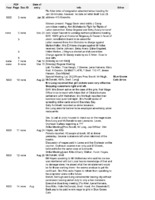 Hotel and Restaurant Employees Union, Local 28 Meeting Minutes - Researchers' Notes Researchers' notes on the Hotel and Restaurant Employees Union Local 28 minute books. Select years: 1932-1933, 1935-1937, 1943, 1946-1948. The original meeting minutes are held at the UBC Rare Books and Special Collections, part of the Original HREU Local 28 minute books Fonds RBSC-ARC-1255 - Hotel, Restaurant and Culinary Employees' and Bartenders' Union, Local 40 fonds.
Hotel and Restaurant Employees Union, Local 28 Meeting Minutes - Researchers' Notes Researchers' notes on the Hotel and Restaurant Employees Union Local 28 minute books. Select years: 1932-1933, 1935-1937, 1943, 1946-1948. The original meeting minutes are held at the UBC Rare Books and Special Collections, part of the Original HREU Local 28 minute books Fonds RBSC-ARC-1255 - Hotel, Restaurant and Culinary Employees' and Bartenders' Union, Local 40 fonds. -
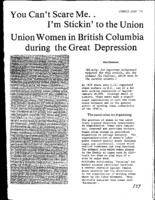 You Can't Scare Me...I'm Stickin' to the Union: Women in British Columbia During the Great Depression A history of the organizing women in the 1930s. Constraints on labour, Women's labour leagues, fishing industry militancy, restaurant strikes, domestic workers conditions, garment workers, saleswomen,
You Can't Scare Me...I'm Stickin' to the Union: Women in British Columbia During the Great Depression A history of the organizing women in the 1930s. Constraints on labour, Women's labour leagues, fishing industry militancy, restaurant strikes, domestic workers conditions, garment workers, saleswomen, -
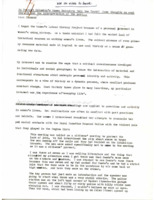 Do women trade unionists tell the truth? Some thoughts on oral history and the intrepretation of the past. An essay by Sara Diamond arguing for the value of women's subjectivities related to everyday lives as recorded in oral histories. A notation on the top of the page in Diamond's handwriting suggests this might become the intro to her unpublished manuscript on women's labour history in British Columbia.
Do women trade unionists tell the truth? Some thoughts on oral history and the intrepretation of the past. An essay by Sara Diamond arguing for the value of women's subjectivities related to everyday lives as recorded in oral histories. A notation on the top of the page in Diamond's handwriting suggests this might become the intro to her unpublished manuscript on women's labour history in British Columbia. -
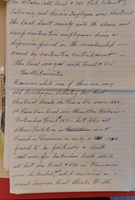 Scrapbook: merger Selected images taken of items from Fonds AM723, File 7. File contains records chronicling the amalgamation of Locals 28, 676 and 835 to form one union, Local 40.
Scrapbook: merger Selected images taken of items from Fonds AM723, File 7. File contains records chronicling the amalgamation of Locals 28, 676 and 835 to form one union, Local 40. -
 Jean Sheils - The Depression Contextual material on the 1930s. In this interview, Jean Sheils discusses disillusionment amongst women during the Great Depression, mother and father’s history with unionism, and their eviction during the Great Depression. She also discusses the single unemployed, the difference in labour struggles from the 1930s to the 1980s, and the On to Ottawa trek. Jean Stewart Evans (1927-1995) was born in Vancouver, BC, second child of Ethel, and well-known labour rights organizer, Arthur “Slim” Evans. She recalls a childhood home always open to organizers and labourers in need, and impacted by her father’s arrests and short-term imprisonments.
Jean Sheils - The Depression Contextual material on the 1930s. In this interview, Jean Sheils discusses disillusionment amongst women during the Great Depression, mother and father’s history with unionism, and their eviction during the Great Depression. She also discusses the single unemployed, the difference in labour struggles from the 1930s to the 1980s, and the On to Ottawa trek. Jean Stewart Evans (1927-1995) was born in Vancouver, BC, second child of Ethel, and well-known labour rights organizer, Arthur “Slim” Evans. She recalls a childhood home always open to organizers and labourers in need, and impacted by her father’s arrests and short-term imprisonments. -
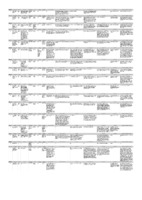 Case Study 1: Oral Histories Research document A thematic guide for the Women's Labour History Project oral histories. This work is ongoing. As of March 2024, we have drawn on oral histories from VIVO Media Arts Centre, SFU Archives, and newspaper interviews . We will soon be working on additions from other archives, like the BC Labour Heritage Centre. This multi-sheet xls spreadsheet includes (1) Object metadata for all interviews; (2) Interviewees biographical details; and (3) Research notes: select excerpts from the interview(s) and details related to our research questions (one sheet per interviewee) ID structure (1) Each interviewee is assigned a letter which is their "Subject ID" (A,B,C, etc.) (2) Each Object (research resource) is assigned an "Object ID" : a combination of the "Subject ID" and a number assigned to delineate each research resource (ie A1, A2, A3, etc). (3) Individual interviewees research sheet is identified using the individual's Subject ID followed by a colon and their surname (ie, A: Fawcett) About our Interviewee Biography sheet Drawing on publicly available resources and implementing genealogical strategies and proof standards, Knights expanded the biographies of the oral history participants. This assisted the researchers with clarifying timelines, locations, and confirming identifies. This latter step was required to ensure that we were researching the correct individual. The women regularly went by nicknames, middle names, maiden names if married, divorced surnames if single, Mrs or Miss irrespective of their actual marital status. It also gives insight into the way waitresses shifted marital status for protection, anonymity, or hirability. The biographic and demographic material also informs the interviewees own statements on why they became involved in union activity or activist movements.
Case Study 1: Oral Histories Research document A thematic guide for the Women's Labour History Project oral histories. This work is ongoing. As of March 2024, we have drawn on oral histories from VIVO Media Arts Centre, SFU Archives, and newspaper interviews . We will soon be working on additions from other archives, like the BC Labour Heritage Centre. This multi-sheet xls spreadsheet includes (1) Object metadata for all interviews; (2) Interviewees biographical details; and (3) Research notes: select excerpts from the interview(s) and details related to our research questions (one sheet per interviewee) ID structure (1) Each interviewee is assigned a letter which is their "Subject ID" (A,B,C, etc.) (2) Each Object (research resource) is assigned an "Object ID" : a combination of the "Subject ID" and a number assigned to delineate each research resource (ie A1, A2, A3, etc). (3) Individual interviewees research sheet is identified using the individual's Subject ID followed by a colon and their surname (ie, A: Fawcett) About our Interviewee Biography sheet Drawing on publicly available resources and implementing genealogical strategies and proof standards, Knights expanded the biographies of the oral history participants. This assisted the researchers with clarifying timelines, locations, and confirming identifies. This latter step was required to ensure that we were researching the correct individual. The women regularly went by nicknames, middle names, maiden names if married, divorced surnames if single, Mrs or Miss irrespective of their actual marital status. It also gives insight into the way waitresses shifted marital status for protection, anonymity, or hirability. The biographic and demographic material also informs the interviewees own statements on why they became involved in union activity or activist movements. -
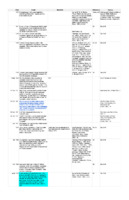 CS1 White Waitresses in Chinatown_Timeline of key events (In progress) In progress: timeline of key events related to the issue of of White waitresses working in Chinatown, Vancouver, cafes and restaurants, and the subsequent implication and application of municipal and provincial regulations and laws. The final timeline will feature the actions by the waitresses implicated, political allies, and the Hotel Restaurant and Employees Union Local 28. Related unpublished resource include demographic and biographical data of the waitresses. Contact the researcher for access.
CS1 White Waitresses in Chinatown_Timeline of key events (In progress) In progress: timeline of key events related to the issue of of White waitresses working in Chinatown, Vancouver, cafes and restaurants, and the subsequent implication and application of municipal and provincial regulations and laws. The final timeline will feature the actions by the waitresses implicated, political allies, and the Hotel Restaurant and Employees Union Local 28. Related unpublished resource include demographic and biographical data of the waitresses. Contact the researcher for access. -
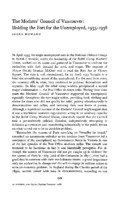 The Mothers' Council of Vancouver: Holding the Fort for the Unemployed, 1935-1938. An article document The Mothers' Council of Vancouver history and their work with the unemployed 1935-1938. Author Irene Howard.
The Mothers' Council of Vancouver: Holding the Fort for the Unemployed, 1935-1938. An article document The Mothers' Council of Vancouver history and their work with the unemployed 1935-1938. Author Irene Howard. -
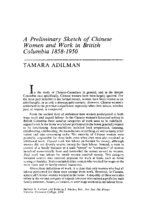 A Preliminary Sketch of Chinese Women and Work in British Columbia 1858-1950. A Preliminary Sketch of Chinese Women and Work in British Columbia 1858-1950 by Tamara Adilman.
A Preliminary Sketch of Chinese Women and Work in British Columbia 1858-1950. A Preliminary Sketch of Chinese Women and Work in British Columbia 1858-1950 by Tamara Adilman. -
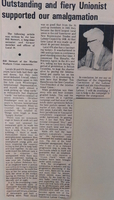 Outstanding and fiery unionist supported our amalgamation A reprint of an article by unionist William "Bill" Stewart on the challenges of organizing, published in commemoration of the amalgamation of Hotel, Restaurant and Employees Union Locals 676 an 28.
Outstanding and fiery unionist supported our amalgamation A reprint of an article by unionist William "Bill" Stewart on the challenges of organizing, published in commemoration of the amalgamation of Hotel, Restaurant and Employees Union Locals 676 an 28. -
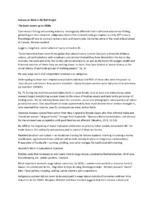 Notes on "Indians at Work in BC" Notes by Sara Diamond on "Indians [First Nations] at Work in BC" by Rolf Knight.
Notes on "Indians at Work in BC" Notes by Sara Diamond on "Indians [First Nations] at Work in BC" by Rolf Knight. -
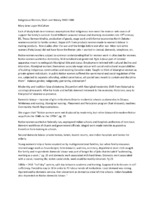 Notes on "Indigenous Women, Work and History 1940-1980" Sara Diamond's notes on "Indigenous Women, Work and History 1940-1980" by Mary Jane Logan McCallum
Notes on "Indigenous Women, Work and History 1940-1980" Sara Diamond's notes on "Indigenous Women, Work and History 1940-1980" by Mary Jane Logan McCallum -
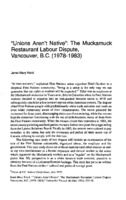 Unions Aren't Native: The Muckamuck Restaurant Labour Dispute Vancouver BC (1978-1983) Essay by Janet Mary Nicol on the Muckamuck dispute affecting First Nations restaurant workers represented by SORWUC,
Unions Aren't Native: The Muckamuck Restaurant Labour Dispute Vancouver BC (1978-1983) Essay by Janet Mary Nicol on the Muckamuck dispute affecting First Nations restaurant workers represented by SORWUC, -
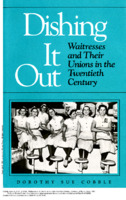 Dishing it Out: Waitresses and their Unions in the Twentieth Century Back when SOS or Adam and Eve on a raft were things to order if youwere hungry but a little short on time and money, nearly one-fourth of all waitresses belonged to unions. By the time their movement peaked in the 1940s and 1950s, the women had developed a distinctive form of working-class feminism, simultaneously pushing for equal rights and pay and affirming their need for special protections. Dorothy Sue Cobble shows how sexual and racial segregation persistedin wait work, but she rejects the idea that this was caused byemployers' actions or the exclusionary policies of male trade unionists.Dishing It Out contends that the success of waitress unionism wasdue to several factors: waitresses, for the most part, had nontraditionalfamily backgrounds, and most were primary wage-earners. Theirclose-knit occupational community and sex-separate union encouragedfemale assertiveness and a decidedly unromantic view of men andmarriage. Cobble skillfully combines oral interviews and extensivearchival records to show how waitresses adopted the basic tenets ofmale-dominated craft unions but rejected other aspects of male unionculture. The result is a book that will expand our understanding offeminism and unionism by including the gender consciousperspectives of working women. [Source: UI Press]
Dishing it Out: Waitresses and their Unions in the Twentieth Century Back when SOS or Adam and Eve on a raft were things to order if youwere hungry but a little short on time and money, nearly one-fourth of all waitresses belonged to unions. By the time their movement peaked in the 1940s and 1950s, the women had developed a distinctive form of working-class feminism, simultaneously pushing for equal rights and pay and affirming their need for special protections. Dorothy Sue Cobble shows how sexual and racial segregation persistedin wait work, but she rejects the idea that this was caused byemployers' actions or the exclusionary policies of male trade unionists.Dishing It Out contends that the success of waitress unionism wasdue to several factors: waitresses, for the most part, had nontraditionalfamily backgrounds, and most were primary wage-earners. Theirclose-knit occupational community and sex-separate union encouragedfemale assertiveness and a decidedly unromantic view of men andmarriage. Cobble skillfully combines oral interviews and extensivearchival records to show how waitresses adopted the basic tenets ofmale-dominated craft unions but rejected other aspects of male unionculture. The result is a book that will expand our understanding offeminism and unionism by including the gender consciousperspectives of working women. [Source: UI Press] -
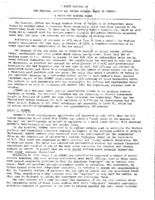 A Brief History of SORWUC A brief history of SORWUC, published by SORWUC.
A Brief History of SORWUC A brief history of SORWUC, published by SORWUC. -
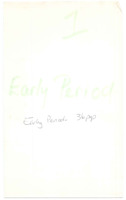 Chambermaids to Whistle Punks: select manuscript chapter drafts Draft chapters from Sara Diamond's unpublished book manuscript, Chambermaids to Whistle Punks
Chambermaids to Whistle Punks: select manuscript chapter drafts Draft chapters from Sara Diamond's unpublished book manuscript, Chambermaids to Whistle Punks -
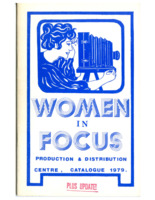 Women In Focus Production & Distribution Centre, Catalogue 1979 [Red stamp: “Plus Update”]. A catalogue of Women In Focus Society produced videos and film to 1977. A 1980 update with international additions by outside producers, slide/sound presentations, leaflets.
Women In Focus Production & Distribution Centre, Catalogue 1979 [Red stamp: “Plus Update”]. A catalogue of Women In Focus Society produced videos and film to 1977. A 1980 update with international additions by outside producers, slide/sound presentations, leaflets. -
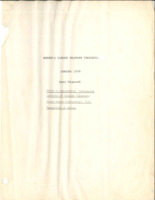 Women's Labour History Project: Summer 1979 Guide to Collection: Provincial Archives of British Columbia; SFU; BC Federation of Labour Oral history summaries / guide to collection. Missing pages 21-24.
Women's Labour History Project: Summer 1979 Guide to Collection: Provincial Archives of British Columbia; SFU; BC Federation of Labour Oral history summaries / guide to collection. Missing pages 21-24. -
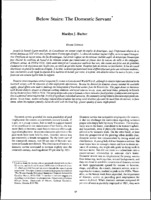 Below Stairs: The Domestic Servant "Below the Stairs: The Domestic Servant" by Marilyn J. Barber.
Below Stairs: The Domestic Servant "Below the Stairs: The Domestic Servant" by Marilyn J. Barber. -
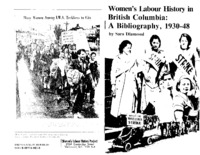 Women's Labour History in British Columbia: A Bibliography, 1930-48 Bibliography of Women's Labour History in British Columbia, 1930-1948 compiled by Sara Diamond. Includes general sources, the depression years, the war years, and the immediate post-war period.
Women's Labour History in British Columbia: A Bibliography, 1930-48 Bibliography of Women's Labour History in British Columbia, 1930-1948 compiled by Sara Diamond. Includes general sources, the depression years, the war years, and the immediate post-war period. -
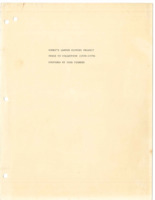 Women's Labour History Project Guide to the Collection (1978-1979) Prepared by Sara Diamond Women's Labour History Project Guide to Collection (1978-1979) prepared by Sara Diamond including women's labour history project interviewees and descriptions.
Women's Labour History Project Guide to the Collection (1978-1979) Prepared by Sara Diamond Women's Labour History Project Guide to Collection (1978-1979) prepared by Sara Diamond including women's labour history project interviewees and descriptions. -
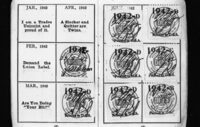 Hotel and Restaurant Employee's Union Local 28 The Hotel Industry was one of the first industries unionized in B.C., the first charter being granted in 1900 to the Hotel and Restaurant Employees' Union Local No. 28. Gradually the smaller locals began merging until 1974, when the Beverage Dispensers' Union, Local No. 676, and the Hotel and Restaurant Employees' Union, Local No. 28, merged to become the Hotel and Restaurant Employees' and Bartenders' Union, local No. 16. The final province-wide merger occurred in 1976 with the creation of the Hotel, Restaurant, and Culinary Employees' and Bartenders' Union, having 12,000 unionized employees under Local 40. [Description from the UBC RBSC Hotel, Restaurant and Culinary Employees' and Bartenders' Union, Local 40 fonds]
Hotel and Restaurant Employee's Union Local 28 The Hotel Industry was one of the first industries unionized in B.C., the first charter being granted in 1900 to the Hotel and Restaurant Employees' Union Local No. 28. Gradually the smaller locals began merging until 1974, when the Beverage Dispensers' Union, Local No. 676, and the Hotel and Restaurant Employees' Union, Local No. 28, merged to become the Hotel and Restaurant Employees' and Bartenders' Union, local No. 16. The final province-wide merger occurred in 1976 with the creation of the Hotel, Restaurant, and Culinary Employees' and Bartenders' Union, having 12,000 unionized employees under Local 40. [Description from the UBC RBSC Hotel, Restaurant and Culinary Employees' and Bartenders' Union, Local 40 fonds] -
 Be Labouring Women's Imagery: The Work of the Women's Labour History Project. A Personal / Public Narrative by Sara Diamond. Presented at a Winnipeg Conference. Essay manuscript for "Be Labouring Women's Imagery: The Work of the Women's Labour History Project - A Personal / Public Narrative" by Sara Diamond.
Be Labouring Women's Imagery: The Work of the Women's Labour History Project. A Personal / Public Narrative by Sara Diamond. Presented at a Winnipeg Conference. Essay manuscript for "Be Labouring Women's Imagery: The Work of the Women's Labour History Project - A Personal / Public Narrative" by Sara Diamond. -
 Finding Aid - Sara Diamond fonds (SD) The Sara Diamond fonds spans her years in Vancouver as a member of the Revolutionary Workers League, Bread and Roses Collective, Amelia Productions, VIVO Media Arts Centre, and the Coalition for the Right To View. There are extensive materials related to Diamond’s Women’s Labour History Project, Code Zebra, curatorial projects, critical writing, educational materials, and independent video art. Diamond's fonds include photographic negatives (35mm) and prints, documents and publications (approx. 30m), audio recordings ( 200+ 1/4# and compact cassette), video recordings (500+ 3/4# Umatic, Betacam, Mini-DV), wearable art, and ephemera.
Finding Aid - Sara Diamond fonds (SD) The Sara Diamond fonds spans her years in Vancouver as a member of the Revolutionary Workers League, Bread and Roses Collective, Amelia Productions, VIVO Media Arts Centre, and the Coalition for the Right To View. There are extensive materials related to Diamond’s Women’s Labour History Project, Code Zebra, curatorial projects, critical writing, educational materials, and independent video art. Diamond's fonds include photographic negatives (35mm) and prints, documents and publications (approx. 30m), audio recordings ( 200+ 1/4# and compact cassette), video recordings (500+ 3/4# Umatic, Betacam, Mini-DV), wearable art, and ephemera. -
 A Bibliography of Women's Trade Union History in BC 1935 - 1950 This is a bibliography of sources for research into the history of women in the B.C. trade union movement. It covers a fifteen year period: 1935-1950. These years were chosen because they represent a time of dramatic changes both in the position of women within production and of the ideology and strength of the organized labour movement in the province. The material in this bibliography is located in the Lower Mainland area. There is additional primary material in the Public Archives of British Columbia, located in Victoria. Permission is needed to use trade union archives. [From the Introduction]
A Bibliography of Women's Trade Union History in BC 1935 - 1950 This is a bibliography of sources for research into the history of women in the B.C. trade union movement. It covers a fifteen year period: 1935-1950. These years were chosen because they represent a time of dramatic changes both in the position of women within production and of the ideology and strength of the organized labour movement in the province. The material in this bibliography is located in the Lower Mainland area. There is additional primary material in the Public Archives of British Columbia, located in Victoria. Permission is needed to use trade union archives. [From the Introduction]
